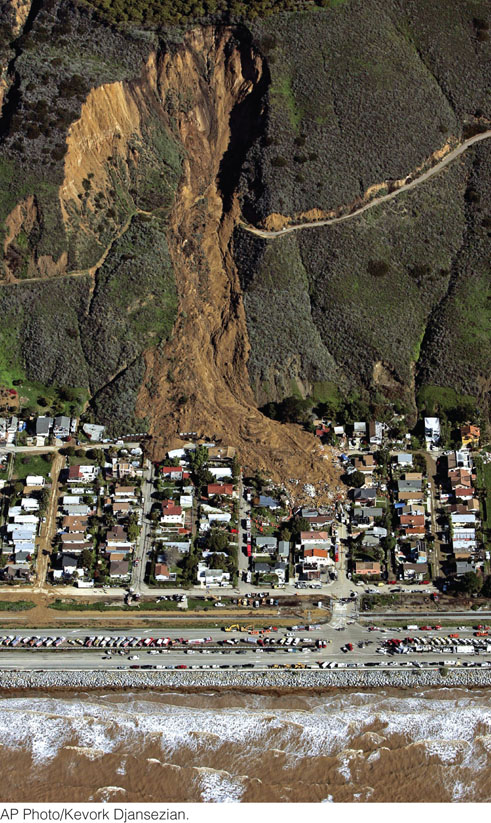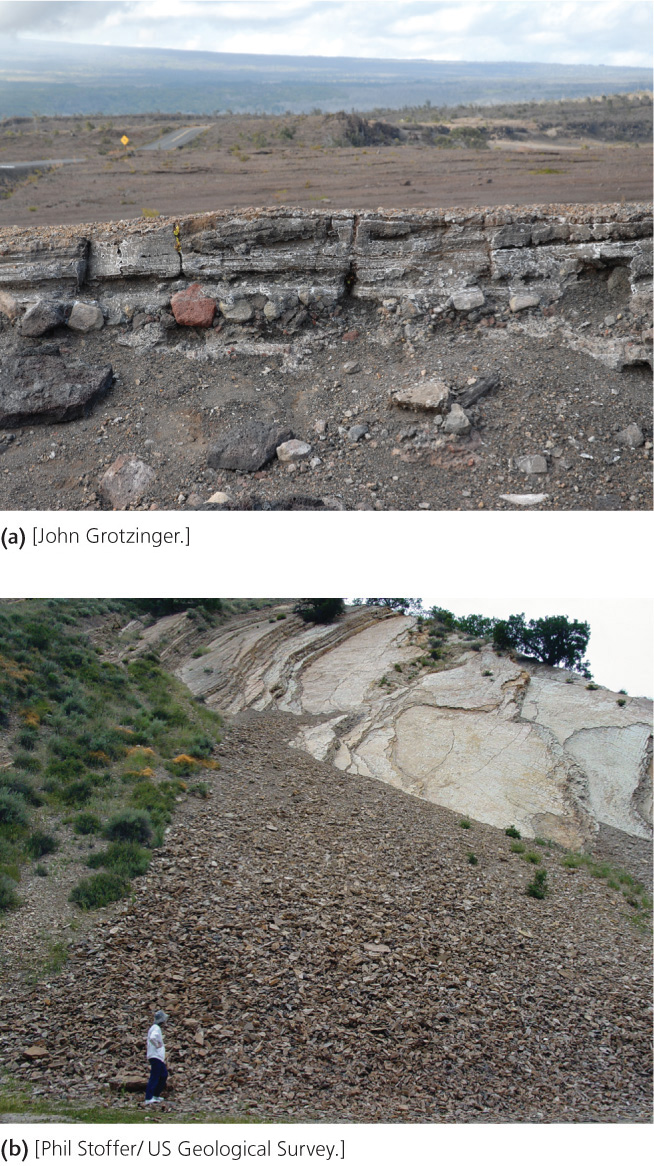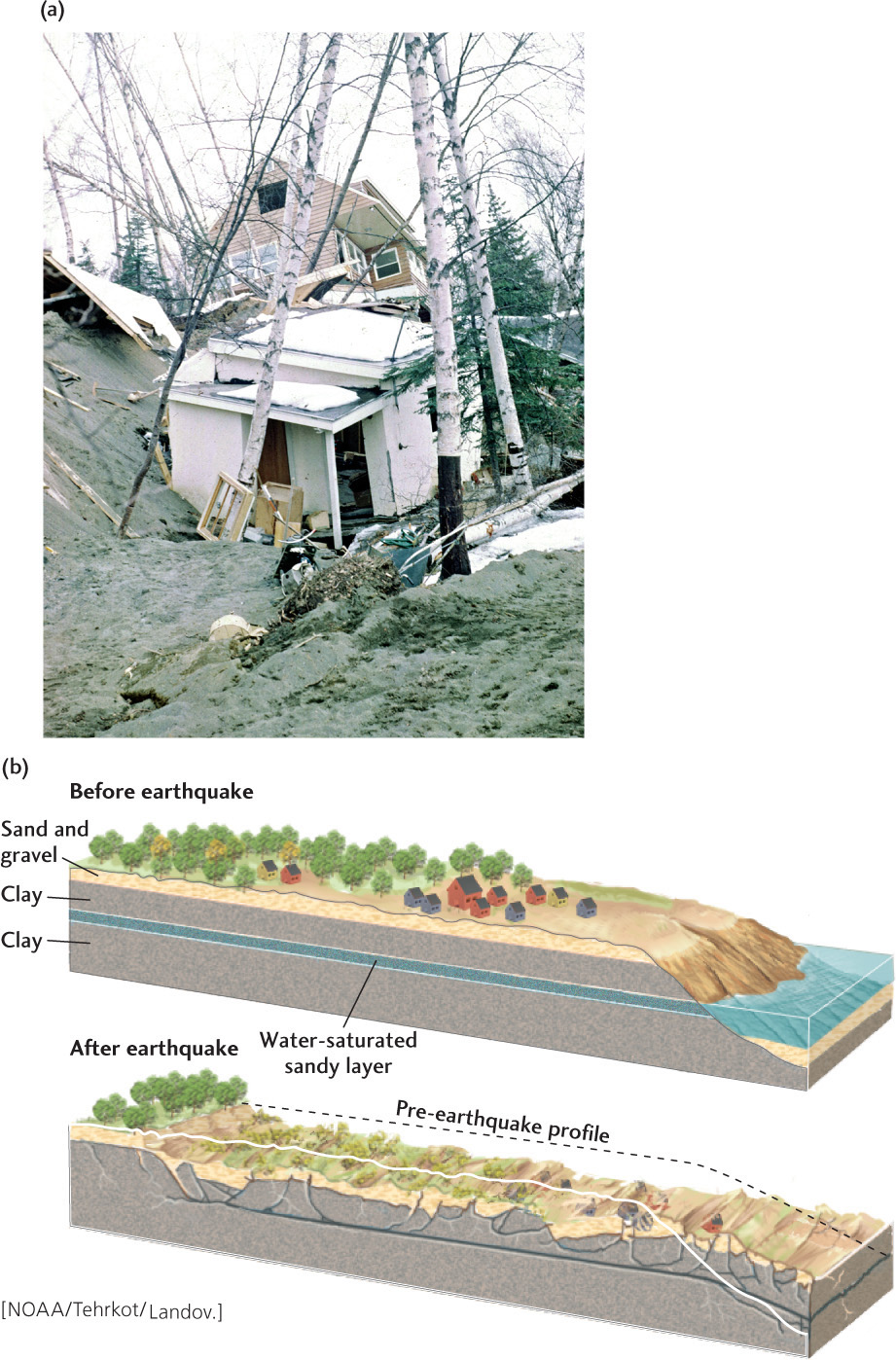Mass Wasting
On the morning of June 1, 2005, as residents of Laguna Beach, California, were waking up and enjoying their morning coffee, the hillside broke loose beneath their feet and collapsed. Seven multi-million-dollar homes were destroyed as a large mass of soil and weathered bedrock gave way and slid downhill. Twelve other homes were badly damaged, and hundreds more were evacuated as residents waited anxiously for geologists to evaluate their home sites and determine whether it was safe to return. Some houses completely collapsed; others literally broke in half; and still others were left stranded at the top of the hill, where they jutted out over a large gash formed where the sliding mass of earth broke away (see the chapter opening photo).
This mass wasting event was triggered by very high seasonal rainfall—the second highest ever recorded for that part of Southern California—which saturated the soil and bedrock and created the necessary conditions in an already unstable geologic environment to tip the scales in favor of disaster. Earlier in the same year, high rainfall had triggered similar events, including one that killed 10 people when homes were buried in La Conchita, California (Figure 16.12).

448
These events in Southern California represent just one of many kinds of downslope movements of masses of soil, rock, mud, or other materials under the force of gravity, known collectively as mass movements. These masses are not pulled downslope primarily by the action of an erosional agent, such as wind, flowing water, or glacial ice. Instead, mass movements occur when the force of gravity exceeds the strength of the slope materials. The materials then move down the slope, sometimes very slowly, sometimes as a large, sudden, catastrophic movement. Mass movements can displace small, almost imperceptible amounts of soil down a gentle hillside, or they can be huge landslides that dump tons of earth and rock on valley floors below steep mountain slopes.
Every year, mass movements take a toll of lives and property throughout the world. In late October and early November of 1998, for example, one of the most catastrophic hurricanes of the twentieth century, Hurricane Mitch, dropped torrential rains on Central America, saturating the ground and causing raging floods and landslides. At least 9000 people were killed, and billions of dollars in damage was done as the floods and slides laid waste to once-fertile land and crops of corn, beans, coffee, and peanuts. One of the hardest-hit areas was near the Nicaragua-Honduras border, where a series of landslides and mudflows buried at least 1500 people. Dozens of villages were simply obliterated, engulfed by a sea of mud. The walls of a crater on Casita volcano collapsed and started a series of slides and flows that were described as a moving wall of mud more than 7 m high. Those in the direct path of the avalanche could not escape, and many were buried alive as they tried to outrun the fast-moving mud.
449
Because mass movements are responsible for so much destruction, we want to be able to predict them, and we certainly want to refrain from provoking them by unwise interference with natural processes. We cannot prevent most natural mass movements, but we can plan construction and land development so as to minimize losses. Mass movements change the landscape by scarring mountainsides as great masses of material fall or slide away from the slopes. The material that moves ends up as tongues or wedges of debris on the valley floor, sometimes piling up and damming a stream running through the valley. Such scars and debris deposits, mapped in the field or from aerial photographs, are clues to past mass movements. By reading these clues, geologists may be able to predict and issue timely warnings about new movements likely to occur in the future.
Mass wasting is influenced by three primary factors (Table 16.4):
- 1. The nature of the slope materials. Slopes may be made up of unconsolidated materials, which are loose and uncemented, or consolidated materials, which are compacted or bound together by mineral cements.
- 2. The amount of water in the materials. This factor depends on how porous the materials are and on how much rain or other water they have been exposed to.
- 3. The steepness of the slope. This factor contributes to the tendency of materials to fall, slide, or flow under various conditions.
| Nature of Slope Material | Water Content | Steepness of Slope | Stability of Slope |
|---|---|---|---|
| UNCONSOLIDATED | |||
| Loose sand or sandy silt | Dry | Angle of repose | High |
| Wet | Moderate | ||
| Unconsolidated mixture of sand, | Dry | Moderate | High |
| silt, soil, and rock fragments | Wet | Low | |
| Dry | Steep | High | |
| Wet | Low | ||
| CONSOLIDATED | |||
| Rock, jointed and deformed | Dry or wet | Moderate to steep | Moderate |
| Rock, massive | Dry or wet | Moderate | High |
| Dry or wet | Steep | Moderate |
All three factors operate in nature, but slope steepness and water content are most strongly influenced by human activity, such as excavation for building and highway construction. All three factors produce the same result: they lower resistance to movement. The force of gravity takes over, and the slope materials begin to fall, slide, or flow.
Slope Materials
Slope materials vary greatly because they are so dependent on the physical properties of the local terrain. Thus, the foliated bedrock of one hillside may be prone to extensive fracturing whereas another slope only a few hundred meters away may be composed of massive granite. Slopes of unconsolidated material are the least stable of all.
Unconsolidated Sand and Silt
The behavior of loose, dry sand and silt illustrates how the steepness of slopes influences mass wasting. Children’s sandboxes have made nearly everyone familiar with the characteristic slope of a pile of dry sand. The angle between the slope of any pile of sand or silt and the horizontal is the same, whether the pile is a few centimeters or several meters high. For most sands and silts, that angle is about 35°. If you scoop some sand from the base of the pile very slowly and carefully, you can increase the slope angle a little, and it will hold temporarily. If you then jump on the ground near the sand pile, however, the sand will cascade down the side of the pile, which will again assume its original slope of 35°.
450
The slope angle of the sand pile is its angle of repose, the maximum angle at which a slope of loose material will lie without cascading down. A slope that is steeper than the angle of repose is unstable and will tend to collapse to the stable angle of repose. Sand or silt grains will form piles with slopes at and below the angle of repose because friction between the individual grains holds them in place. However, as more and more grains are placed on the pile and the slope steepens, the ability of the frictional forces to prevent sliding decreases, and the pile suddenly collapses.
The angle of repose varies with a number of factors, one of which is the size and shape of the particles (Figure 16.13a). Larger, flatter, and more angular pieces of loose material remain stable on steeper slopes. The angle of repose also varies with the amount of moisture between particles. The angle of repose of wet sand is higher than that of dry sand because the small amount of moisture between the grains tends to bind them together so that they resist movement. The source of this binding tendency is surface tension: the attractive force between molecules at a surface (Figure 16.13b). Surface tension is what makes water drops spherical and allows a razor blade or paper clip to float on a smooth water surface. Too much water between particles, on the other hand, separates the particles and allows them to move freely over one another. Saturated sand, in which all the pore space is occupied by water, runs like a fluid and collapses to a flat pancake shape (Figure 16.13c). The surface tension that binds damp sand allows beach sculptors to create elaborate sand castles (Figure 16.14), but when the tide comes in and saturates the sand, the structures collapse. Similarly, but at a much larger scale, landslides on hillslopes depend on water abundances in soils. Heavy rainfall may saturate pore spaces on a slope, causing catastrophic ground failure.


Unconsolidated Mixtures
Slope materials composed of mixtures of unconsolidated sand, silt, clay, soil, and fragments of rock (often called debris) will form slopes with moderate to steep angles (see Table 16.4). The platy shape of clay minerals, the organic content of soils, and the rigidity of rock fragments are all key factors that affect the ability of the material to form slopes with a specific angle.
Consolidated Materials
Slopes of consolidated dry materials—such as rock, compacted or cemented sediments, and vegetated soils bound together by plant roots—may be steeper and less regular than slopes consisting of unconsolidated materials. They can become unstable when they are oversteepened or denuded of vegetation. The particles of some consolidated sediments, such as dense clays, are bound together by cohesive forces associated with tightly packed particles. Cohesion is an attractive force between particles of a solid material that are close together. The greater the cohesive forces in a material, the greater the resistance to movement.
Water Content
The effect of water on consolidated materials is similar to its effect on unconsolidated materials. Mass movements of consolidated materials can usually be traced to the effects of moisture, often in combination with other factors, such as the loss of vegetation or the steepening of a slope. When the ground becomes saturated with water, the planes of weakness within the solid material are lubricated, the friction between particles is lowered, and the particles or larger aggregates can move past one another more easily, so that the material may start to flow like a fluid. This process is called liquefaction.
451
Slope Steepness
Rock slopes range from the relatively gentle inclines of easily weathered shales and volcanic ash beds to vertical cliffs of massive granite. The stability of rock slopes depends on the weathering and fragmentation of the rock. Shales, for example, tend to weather easily and fragment into small pieces that form a thin layer of loose, angular rock fragments (often called rubble) covering the bedrock (Figure 16.15a). The resulting angle of repose is similar to that of loose, coarse sand. The weathered rubble gradually builds up beyond the angle of repose and becomes unstable, and eventually some of it slides downhill.

(b) Talus accumulates on slopes where large blocks of rock fall or roll downhill to form a cone-shaped pile.
In contrast, limestones and hard, cemented sandstones in arid environments resist erosion and break into large blocks, forming steep, bare bedrock slopes above and gentler slopes covered with broken rock (often called talus) below (Figure 16.15b). The bedrock cliffs are fairly stable, except for the occasional mass of rock that falls and rolls down to the rock-covered slope below. Where such limestones or sandstones are interbedded with shale, slopes may be stepped (see Figure 8.12). As shale slides from under the harder beds, those beds are undercut, become less stable, and eventually fall as large blocks.
452
The steepness of individual sedimentary beds also has an influence on slope stability. Mass movements are most likely when the dip of the beds close to the surface is parallel to the slope.
Triggers of Mass Movements
When the right combination of materials, moisture, and steepness makes a slope unstable, a mass movement is inevitable. All that is needed is a trigger. Sometimes a landslide, like the one at Laguna Beach, is provoked by a heavy rainstorm. Many mass movements are set off by vibrations, such as those that occur in earthquakes. Others may be precipitated by gradual steepening due to erosion that eventually results in sudden collapse of the slope.
Geologic reports can help to minimize the human cost of mass movements (see Practicing Geology), but only if municipal planners and individual home buyers heed those reports and avoid building or buying in unstable areas. The devastating mass movements in Southern California during 2005 were clearly related to the unusually high seasonal rainfall during the winter of 2004–2005. That rainfall, however, was related to El Niño conditions (described in Chapter 15), which Earth scientists now understand to recur on a regular basis.
Similarly, most of the damage in the great Alaska earthquake of March 27, 1964, was caused by the slides it triggered. Mass movements of rock, earth, and snow wreaked havoc in residential areas of Anchorage, and there were major submarine slides along lakeshores and the seacoast. Huge landslides took place along the flat plains below the 30–35-m-high bluffs along the coast. The bluffs were composed of interbedded clays and silts. During the earthquake, the ground shook so hard that unstable, water-saturated sandy layers in the clay were transformed into fluid slurries. Enormous blocks of clay and silt were shaken down from the bluffs and slid along the flat ground with the liquefied sediments, leaving a completely disrupted terrain of jumbled blocks and broken buildings (Figure 16.16). Houses and roads were carried along by the slides and destroyed. The whole process took only 5 minutes, beginning about 2 minutes after the first shock of the earthquake. At one locality, three people were killed and 75 homes were destroyed.

453
Studies of slope stability in both California and Alaska, and of the likelihood of repeated high rainfall or earthquakes in those regions, had indicated that both areas were prime candidates for landslides. A geologic report issued more than a decade before the quake had warned of the hazards of development in the part of Alaska that suffered the most damage, but the scenic beauty of the area overwhelmed people’s judgment. The same is true of Southern California. In Alaska, people paid the price with their lives. Fortunately, at Laguna Beach, the cost was only the value of people’s homes, but even that was steep in an area where the average price of a house was well over a million dollars.